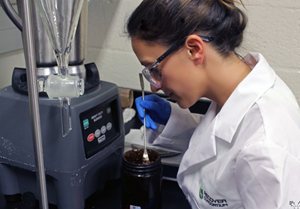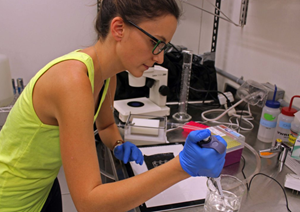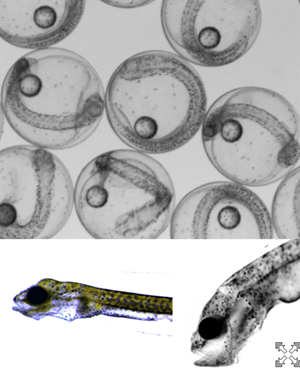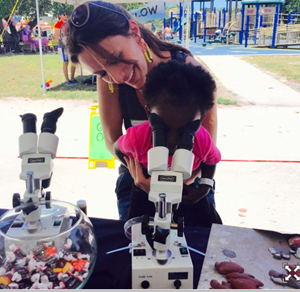
Christina analyzes different life stages of mahi-mahi embryos under a stereomicroscope. (Photo by Dan DiNicola)
Studies that investigate the effects of oil exposure on developing fish are typically conducted at otherwise non-stressful ambient conditions, which may result in conservative impact estimates. Christina Pasparakis is studying the combined effects of oil exposure and other environmental stressors to create a more comprehensive assessment of Deepwater Horizon impacts.
Christina is a marine science Ph.D. student at the University of Miami and a GoMRI Scholar with the RECOVER consortium.
Her Path
Christina grew up on Key Biscayne, a south Florida island, where she developed a deep appreciation for the ocean and marine life. She was five years old when Hurricane Andrew devastated south Florida, including Key Biscayne’s once-flourishing Bill Baggs Cape Florida State Park. A few years later, however, salt marshes and mangrove ecosystems brimming with new forms of marine life had replaced the invasive Australian Pines that once dominated the park. “Watching the island regenerate after such a profound natural disaster, I learned a valuable lesson: nature is, in fact, remarkably resilient,” she explained. “It solidified my interest in studying nature and its incredible ability to adapt to changing conditions.”

Christina makes a high-energy water-accommodated fraction (HEWAF) from surface oil. These WAF dilutions will be used in exposure experiments with embryonic mahi-mahi. (Photo by Dan DiNicola)
As Christina completed her biology master’s degree at San Francisco State University in 2013 and entered the University of Miami’s Ph.D. program in marine science, news about the Deepwater Horizon oil spill deeply saddened her. She became increasingly concerned as the spill’s ecological severity grew over time. When her advisor Dr. Martin Grosell started a multi-year oil spill research project in 2015, which continued his Natural Resources Damage Assessment oil-impact studies, Christina began researching oil’s effects on the developing Gulf fish whose spawning period temporally and geographically overlapped with the Deepwater Horizon event.

Christina hydrates a microplate used for high-throughput oxygen consumption data in small organisms, such as embryos and larvae. (Photo by Dan DiNicola)
Her Work
Recent studies suggest that oil toxicity may cause cardiovascular and morphological abnormalities in the embryonic and larval stages of developing fish. These sublethal effects of oil exposure may have subtle, yet ecologically significant, long-term consequences on entire fish populations. Christina is currently focused on understanding factors that affect developing embryos’ buoyancy, a critical aspect of their survival that helps promote dispersal and positioning of hatched larvae in the food-laden upper water column.

Stereomicroscope images of early life stage mahi-mahi at different developmental periods. The embryos (top) are 2 days post-fertilization and a few hours away from hatch, while the larvae (bottom left and right) are 2-3 days post-hatch. (Image by Christina Pasparakis)
Christina conducts exposure experiments on mahi-mahi at early developmental life stages using varying concentrations and types of oil (such as surface oil or source oil) and different environmental stressors, such as UV radiation, temperature, and salinity. She then quantifies changes in embryonic buoyancy over time, measures their sinking rate and nitrogenous waste excretion, and uses optical and imaging systems to assess oxygen consumption, cardiac function, and overall development. “All of these variables have significant implications for fish survival and growth to later life-stages,” explained Christina. “For example, embryos sinking down the water column earlier in development could place them in unfavorable conditions for hatching and post-hatch feeding and may increase predation risk.”
So far, Christina’s research has found that larvae who were exposed to oil as embryos displayed increased oxygen consumption rates, indicating elevated metabolic rates and the potential for corresponding increases in energy depletion. She observed depletions in embryonic mahi-mahi yolk sacs, the sole energy substrates for most developing fish embryos, which confirmed the projected energy depletion. Her results are the first to demonstrate increased energy demand and energy depletion in oil-exposed fish embryos and larvae.

Christina at the University of Miami-sponsored Ocean Kid’s Day, a program that invites children from low-performing, high-needs elementary schools to participate in a day of marine science adventures. Here, she shows a young girl how early life stages of live mahi-mahi look under a microscope. (Photo by Elena Papademetriou)
Her Learning
Christina’s Ph.D. research has taught her the importance of creating a strong foundation of knowledge and expertise before jumping into an experiment. Troubleshooting the oxygen-sensing system she used to measure oxygen consumption was a long, tedious, and often frustrating process that did not produce any useable results. Reflecting on that process today, however, she has a much different perspective. “Those months of troubleshooting and method development were arguably some of the most valuable and character building experiences of my Ph.D.,” she explained. “It helped me test my boundaries and taught me that creativity and improvisation are critical skills in science.”
Christina believes in the importance of investing in future scientists. She initially found training and supervising undergraduate volunteers in the Grosell lab especially challenging and asked for a different lab duty. However, Grosell insisted that a person can only excel by improving on their weaknesses and assigned her even more undergraduates – it was ultimately one of the most fulfilling aspects of her Ph.D. “I learned how to be simultaneously critical and motivating and became a much more qualified mentor and teacher,” she said. “Watching my current undergraduate volunteer grow as a scientist and conduct experiments alone has been very rewarding and has solidified my passion to teach in the future.”
Participation in outreach activities with local students through the University of Miami’s Rosenstiel School of Marine and Atmospheric Science has been an important part of Christina’s growth. She volunteered with Ocean Kids, a University of Miami-sponsored program that introduces at-risk grade school students to science. She also helped with Women in Science Day to inspire young girls to pursue scientific careers. “My volunteer activities provided an effective way to motivate younger generations to care about the sustainability and preservation of our ocean and fisheries,” said Christina. “I believe spreading knowledge about the destructive consequences of environmental catastrophes such as the Deepwater Horizon oil spill will help prevent these disasters from happening in the future and better prepare us for when they do occur.”
Her Future
Christina wants a career that will allow her to study, learn, and teach about oceans and their ability to adapt and recover during periods of rapid environmental change. She hopes to continue spreading awareness about the current state of marine ecosystems and how global climate change, increased pollution, and environmental disasters risk oceans’ sustainability and diverse marine life. “Motivation requires optimism,” she concluded. “Despite recent studies displaying dire projections for the future, we must find a way to focus on the positive and believe in the resilience of nature.”
Praise for Christina
Dr. Grosell noted that, in addition to pursuing her own research, Christina plays a central role in numerous collaborative projects with visiting scientists and University of Miami colleagues. “The ability to develop equipment and techniques for sophisticated measurements is a hallmark of an outstanding Ph.D. student. In Christina, these skills are combined with strong writing skills, and she consistently connects well with broad audiences,” said Grosell. “I view Christina as an exceptionally strong young scientist with immense potential.”
The GoMRI community embraces bright and dedicated students like Christina Pasparakis and their important contributions. The GoMRI Scholars Program recognizes graduate students whose work focuses on GoMRI-funded projects and builds community for the next generation of ocean science professionals. Visit the RECOVER website to learn more about their work.
************
The Gulf of Mexico Research Initiative (GoMRI) is a 10-year independent research program established to study the effect, and the potential associated impact, of hydrocarbon releases on the environment and public health, as well as to develop improved spill mitigation, oil detection, characterization and remediation technologies. An independent and academic 20-member Research Board makes the funding and research direction decisions to ensure the intellectual quality, effectiveness and academic independence of the GoMRI research. All research data, findings and publications will be made publicly available. The program was established through a $500 million financial commitment from BP. For more information, visit http://gulfresearchinitiative.org/.
